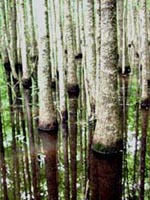Resource Library
Plant of the Week: Water Tupelo
The University of Arkansas System Division of Agriculture does not promote, support or recommend plants featured in "Plant of the Week." Please consult your local Extension office for plants suitable for your region.
Plant of the Week
Water Tupelo
Latin: Nyssa aquatica

Anniversaries come and go, but we seem to assign more significance to the ones with zeros attached.
So, with the 200th anniversary of Mr. Jefferson’s good deal upon us and the Lewis and Clark festivities underway, I thought I should do my part by inspecting Arkansas’ contribution to the festivities - the Louisiana Purchase State Historic Park. The marker is in the middle of an east Arkansas swamp crowded with trees, especially the water tupelo.
The water tupelo (Nyssa aquatica) is a deciduous tree capable of reaching heights of 90 feet with trunks that are funnel shaped at the base but then shoot skyward with little taper or branching. In the park, the trees huddle close together in the coffee-colored swamp water, reluctantly sharing their space with scattered bald cypress, red maples and a few oaks.
Water tupelo leaves are 7 inches long, thin, occasionally wavy-margined and oval with a pointed tip. In the fall, they turn orange or red, but not as intensely as their upland cousin, the black gum. The flowers are inconspicuous but inch-long, blue-black berries form every fall and are relished by turkeys and an array of songbirds that live in the swamp.
The Louisiana Purchase State Park is about 35 miles south of I-40 at the Brinkley exit on Highway 49. The park commemorates the survey work Congress commissioned in 1815 and marks the boundaries of present day Lee, Monroe and Phillips counties. The impetus for the survey was to permit the federal government to pay veterans of the War of 1812 in land grants from land situated in the newly acquired territory.
The east-west line corresponds to the national baseline and was surveyed by Joseph Brown while the north-south line, 26 miles inland from the Mississippi River, represents the fifth principle meridian and was surveyed by Prospect K. Robbins and extends the uniform surveying quadrants established in the eastern states. All official survey records from the mountains of Montana to the mouth of the Mississippi originate from this marker.
Robbins’ survey crew crossed the east-west line on Nov. 10, 1815. The surveyors described the area as "low and contained cypress and briers and thickets in abundance". In 1921, a survey crew following the Lee - Phillips county line came across "witness" trees marked by the original surveyors and recognized the significance of their find. The monument marking the spot was added in 1926.
The park sits amidst the area cotton and soybean fields in the deep, fertile soils of the Mississippi River flood plane. The marker is accessed by a 950-foot boardwalk that keeps your feet dry but gives a sense of what early explorers and travelers must have encountered when they ventured into the swampy lowlands of the region.
The word "tupelo" is a Creek name transliterated from "ito opilwa," literally "tree and swamp." The Latin name Nyssa continues the watery theme, being based on the name of one of the water nymphs of Greek mythology. The water tupelo is native to the gulf costal plane and the lower reaches of the Mississippi river watershed. In central Arkansas, a nice stand can be seen along the south side of I-40 near Conway in the inundated backwater near where Cadron Creek joins the Arkansas River.
Like many swamp dwellers, water tupelo is perfectly at home in a dryland site. In cultivation it makes a medium size tree of about 50 feet with a decidedly upright habit and limbs arising from the trunk at right angles. While less frequently grown than the upland black gum, it’s easy to find from nursery sites on the Internet.
By: Gerald Klingaman, retired
Extension Horticulturist - Ornamentals
Extension News - June 6, 2003
The University of Arkansas System Division of Agriculture does not maintain lists of retail outlets where these plants can be purchased. Please check your local nursery or other retail outlets to ask about the availability of these plants for your growing area.